I have spent a combined three months house sitting in Tasmania over the last few years. I thought the highlight of my visit was going to be hiking or food (and both of those were AH-mazing). But the true highlight for me ended up being the wildlife in Tasmania.
Tasmania has relatively few people and lots of wilderness areas, so it is just teeming with animals! I had so many amazing encounters with animals in the wild. If you know where to look, and have a little bit of patience, it’s actually fairly easy to see most Tasmanian wildlife without visiting a zoo or wildlife centre.
I travelled all over the state, so I’ve put together a big list of the best places to see wildlife in Tasmania. This post includes:
- Tips for ethical wildlife viewing
- Wildlife spotting tips
- A big list of which animals you can see in Tasmania
- Info on the 10 best places to see wildlife in Tasmania
Hey there: Some of the links in this post are affiliate links, which means I earn a small commission at no extra cost to you if you make a purchase. Thanks for your support! -Taryn
How to Ethically View Wildlife in Tasmania
Animals are amazing and a lot of us (me included) sometimes totally forget to be compassionate when faced with a cute animal. We want to get closer to them or even to touch them. But when we forget to think before we act, we can actually harm the animals we are so excited to see.
Whether through ignorance or deliberate action, tourists and tourism operators can end up hurting, harassing, or otherwise negatively impacting wildlife. Do your research before you participate in wildlife tourism. Here are my tips for ethical wildlife viewing.
1. Avoid Zoos
In general, zoos make me pretty sad. Even when the animals have large, natural looking enclosures, you know that they aren’t living their best life the way they would in the wild.
Some zoos have a conservation focus, housing breeding populations of endangered animals in the hopes of keeping the species alive.
But often, most zoos exist to profit off of using animals to entertain humans. And to me, that isn’t really fair to the animals since they didn’t sign-up for that.
2. Choose a Wildlife Sanctuary or Rehabilitation Centre Instead of a Zoo
If you must visit a zoo or wildlife park in Tasmania (or anywhere else in the world) do a bit of research before you go.
Look for facilities that have a good reputation for animal welfare, have rehabilitation programs for sick or injured animals, or participate in breeding programs for endangered animals.
Avoid zoos that allow you to pick up or pet animals for a fee. This is super stressful for the animals and is only done for profit.
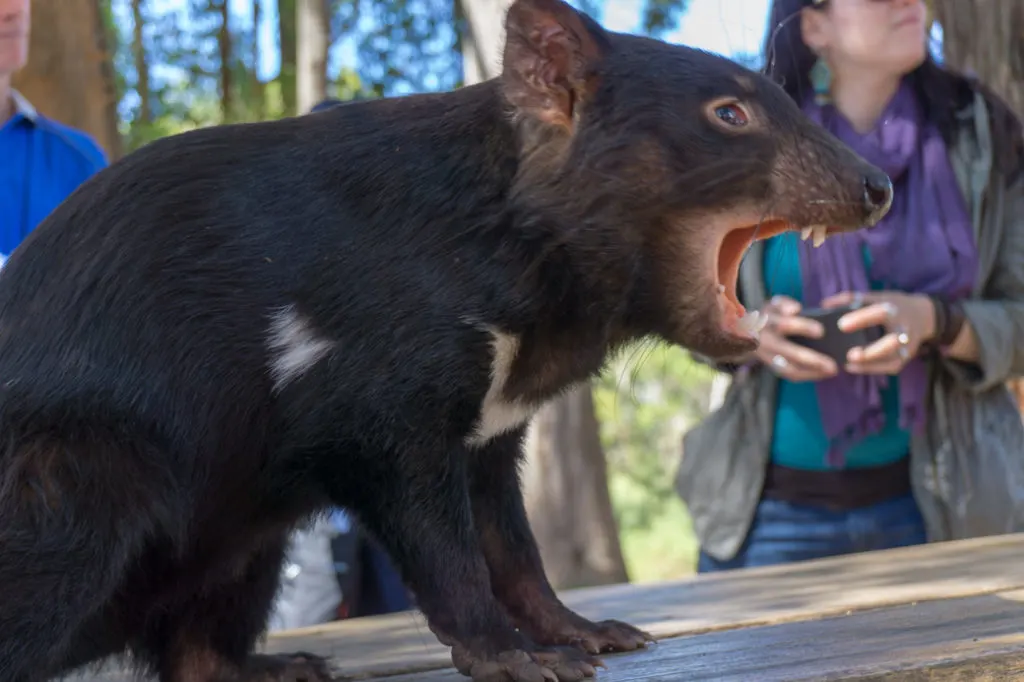
Full disclosure: I did visit one wildlife sanctuary in Tasmania, Trowunna Wildlife Sanctuary in the North West. It has an excellent reputation for caring for sick and injured native wildlife and is one of the most important breeding centres for endangered Tasmanian devils.
They only have native Tasmanian wildlife at the facility and don’t import animals specifically for display like many zoos. In general, I felt that I learned a lot about the animals from their guided tour and was impressed with their dedication to saving Tasmanian devils. However, they do allow visitors to hand feed their kangaroos and some of their enclosures were a bit small, so I have mixed feelings about my visit.
If you must visit a zoo in Tasmania, Trowunna is a good choice. From my research, Bonorong Wildlife Sanctuary near Hobart and the Tasmanian Devil Unzoo on the Tasman Peninsula are other good options.
3. Choose an Ethical Wildlife Tour
I didn’t take any wildlife tours while I was in Tasmania, but it’s definitely on my list. Since I was in Tassie for over a month on each visit, I had lots of time to go out and try to see animals on my own, but most visitors don’t have time for that. That’s where an organized tour comes in.
When booking a tour, do your research and find a tour operator with an ethical reputation. Avoid tours that allow you to touch wild animals. Don’t support tour operators that feed or bait animals. And of course avoid tours that get too close to wildlife or harass them.
4. Don’t Get Too Close
I think the best (and most magical) way to see animals is in the wild. Thankfully in Tasmania that isn’t that hard. However, you need to be respectful when encountering animals.
Give wildlife plenty of space to do their thing. Use binoculars or the zoom lens for your camera for a better look instead of getting too close.
If the animal is acting nervous or staring at you, you’re probably uncomfortably close. To keep the right distance, use the rule of thumb: Close one eye and hold your thumb up in front of you. If your thumb doesn’t cover the animal, you’re too close.
5. Never Feed Wildlife
It should go without saying, but never feed wild animals. It’s not good for their digestive system and can make them sick. As well, it teaches them to rely on humans for food, which turns them into pests and disrupts their normal hunting and foraging behaviours. Make sure you secure your food and rubbish at night if you are camping, as it attracts animals as well.
Read more about how to respect wildlife in my article about Leave No Trace.
Tips for Spotting Wildlife in Tasmania
1. Go at Dawn and Dusk
Many animals in Tasmania are nocturnal, meaning they sleep during the day are are active at night. Birds, ocean mammals and reptiles are active during the day, but pretty much all other animals are asleep.
You can go out at night with a flashlight (torch) but your light will startle the animals. For the best chance to see animals acting naturally, go out at dawn and dusk when there’s enough light to see. Many Tasmanian animals are the most active at that time as well.
2. Go For a Hike
Obviously parks are a great place to see wildlife in Tasmania. But if you hang around the visitor centre with everyone else, you won’t see as much as you will when you head off on a hike. Pick less travelled trails and walk quietly.
3. Stay Overnight
Since most Tasmanian animals are most active at night, book a night in a wilderness lodge or go camping. Once the sun starts to set, lots of animals will start showing up. Camping is even better than staying in a lodge since many animals have become habituated to people (and sadly to their food) and wander around without fear.
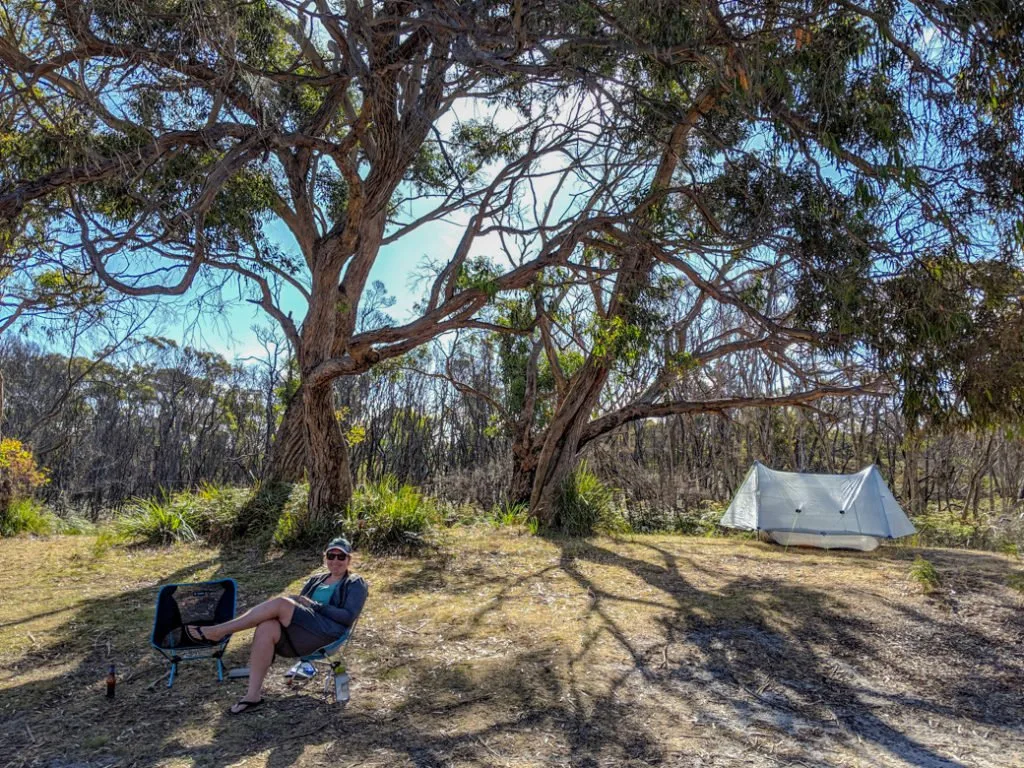
4. Listen Carefully
Don’t just look for animals, listen for them too. Kangaroos, wallabies and pademelons make thumping noises as they hop. Echidnas rustle in the bushes. Seals bark. Birds chirp and sing. And Tassie Devils… make horrible Tassie Devil sounds. Wait quietly and listen, you’ll be surprised at what you can see.
Which Animals Can You See in Tasmania?
Tasmania is home to most of the quintessentially Australian animals. But they also have a few endemic animals that live only in Tasmania, such as the Tasmanian Devil. It’s also worth noting that there are no dingoes or koalas in Tasmania – you’ll have to go to the Australian mainland to see them.
Here’s a brief rundown on some of the key animals you can see in Tasmania:
Tasmanian Devils
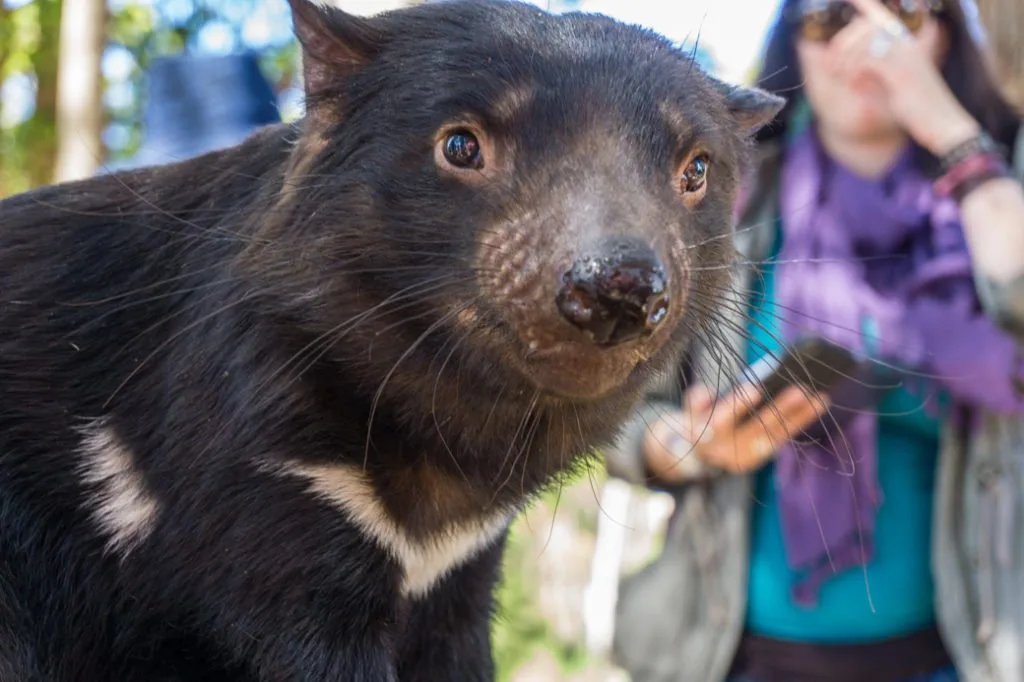
Known locally as Tassie devils or just devils, Tasmanian devils are the state’s most famous animal. They are about the size of a small dog (about 65cm/26″ long) and look pretty different than Taz, the cartoon version.
While they do make a pretty terrible noise, they don’t really attack people or other animals since they eat carrion (dead animals). Their vicious reputation comes from all the fighting they do with other devils over tasty, tasty carcasses. They are most active at night.
Tasmanian devils are currently endangered as their population has been decimated by a contagious facial tumour disease. That makes them very rare to see in the wild. Several wildlife parks have captive breeding programs to build up the devil population with healthy animals that are then released into the wild.
Best places to see Tasmanian devils in Tasmania: Maria Island, Tarkine region, Tasman peninsula
Kangaroos
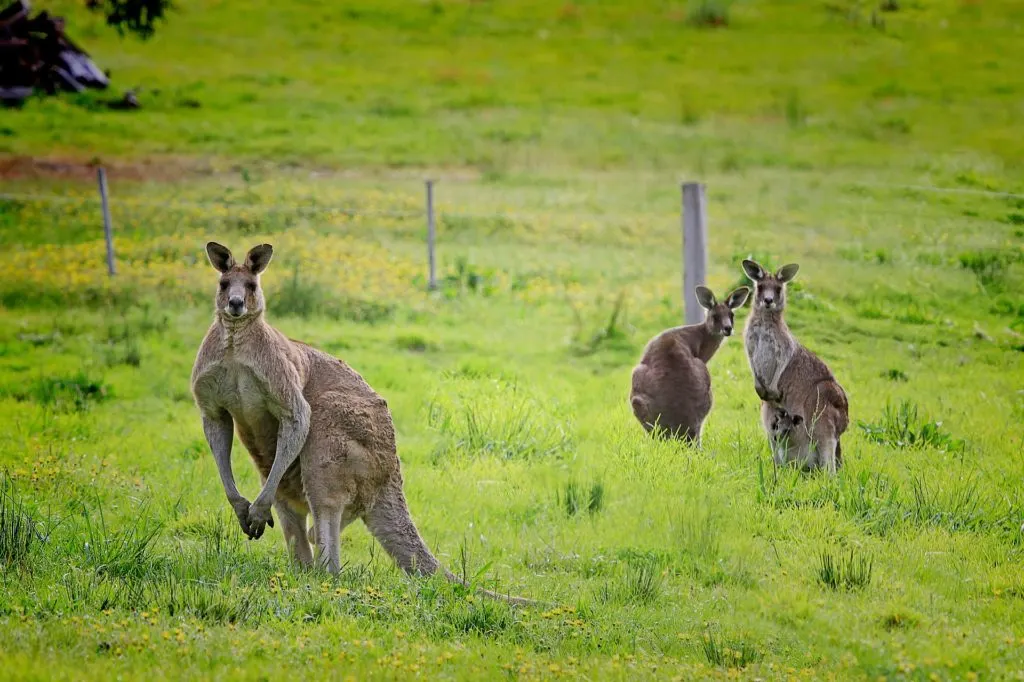
These large hopping marsupials are the national animal of Australia. Kangaroos aren’t very common in Tasmania, but there are small populations of Eastern Grey Kangaroos.
They live in large groups, called mobs or troops and feed on grasses. The males can be up to 2m (6’6″) tall and really muscular, so make sure you keep your distance. Kangaroos are most active at night, as well as dawn and dusk.
Best places to see kangaroos in Tasmania: Maria Island, Narawntapu National Park
Wallabies
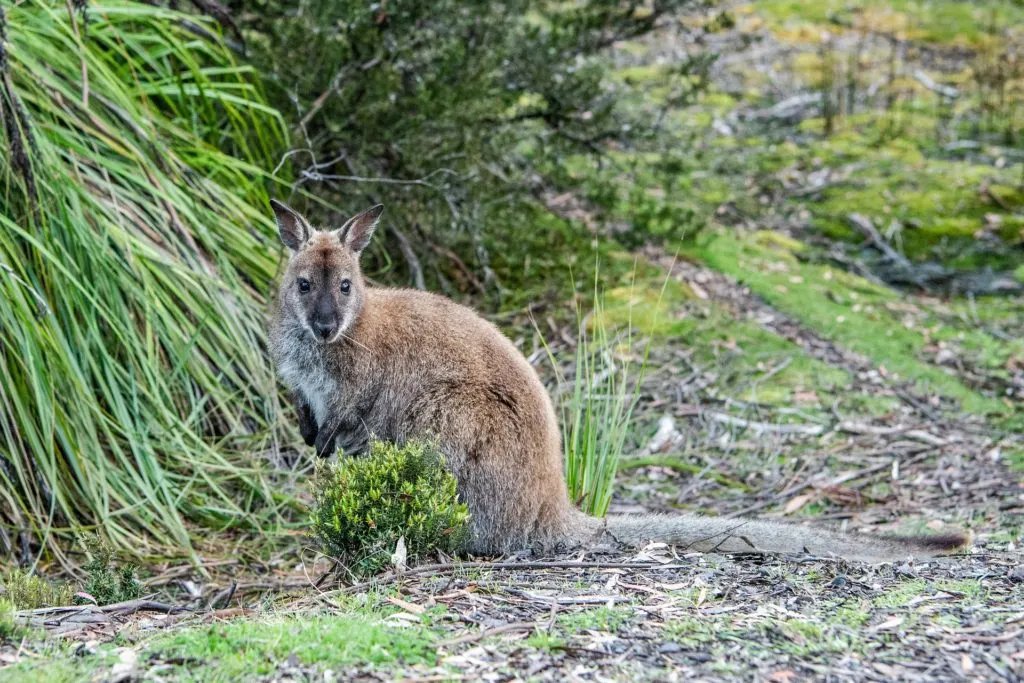
Wallabies are related to kangaroos, but they are smaller, growing to about 90cm (36″) on average. They eat grasses and leaves so you will usually see them in bushy areas. They travel alone or in small family groups, typically consisting of younger wallabies and their mother.
You can find wallabies all over Tasmania, including in suburban areas. The place we were housesitting had wallabies living in the bush across the street.
Best places to see wallabies in Tasmania: Cradle Mountain National Park, Fortescue Bay Campgrounds, Maria Island, and Bruny Island for white (albino) wallabies
Pademelons
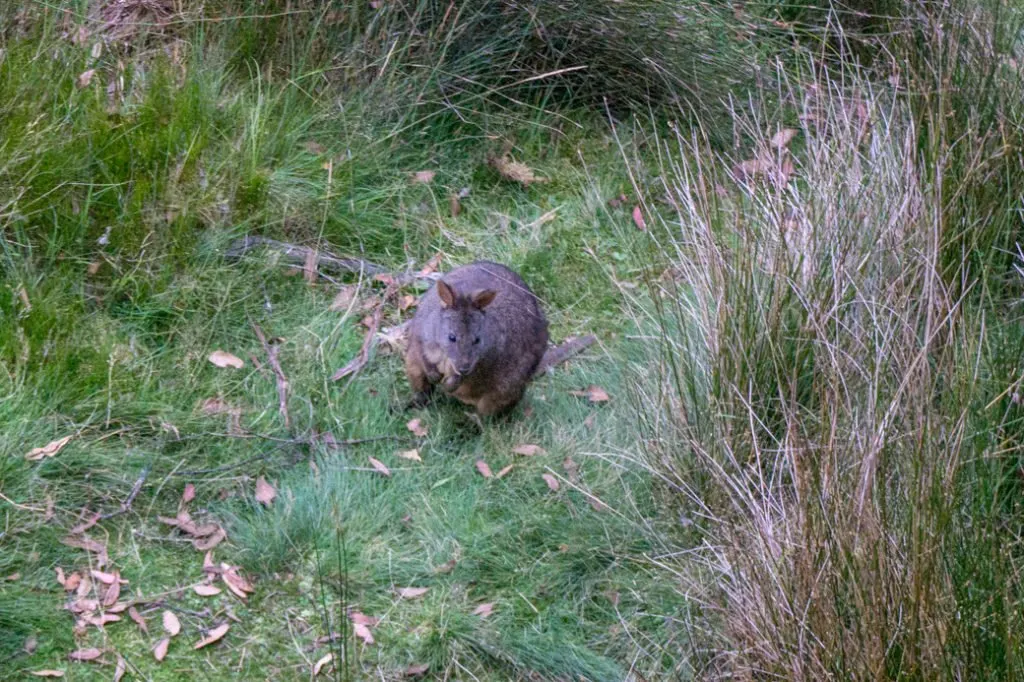
Pademelons are also related to kanagroos and wallabies, but they are even smaller, standing about 50cm (20″) tall. They are shy little creatures so they can be hard to spot since they live in the forest.
It can be a bit tough to tell if you are looking at a pademelon or a small wallaby so here are some tips to tell the difference: Tasmanian pademelons have pointier noses, shorter more triangular ears and smaller back legs than wallabies.
Best places to see pademelons in Tasmania: Maria Island, Cradle Mountain National Park
Wombats
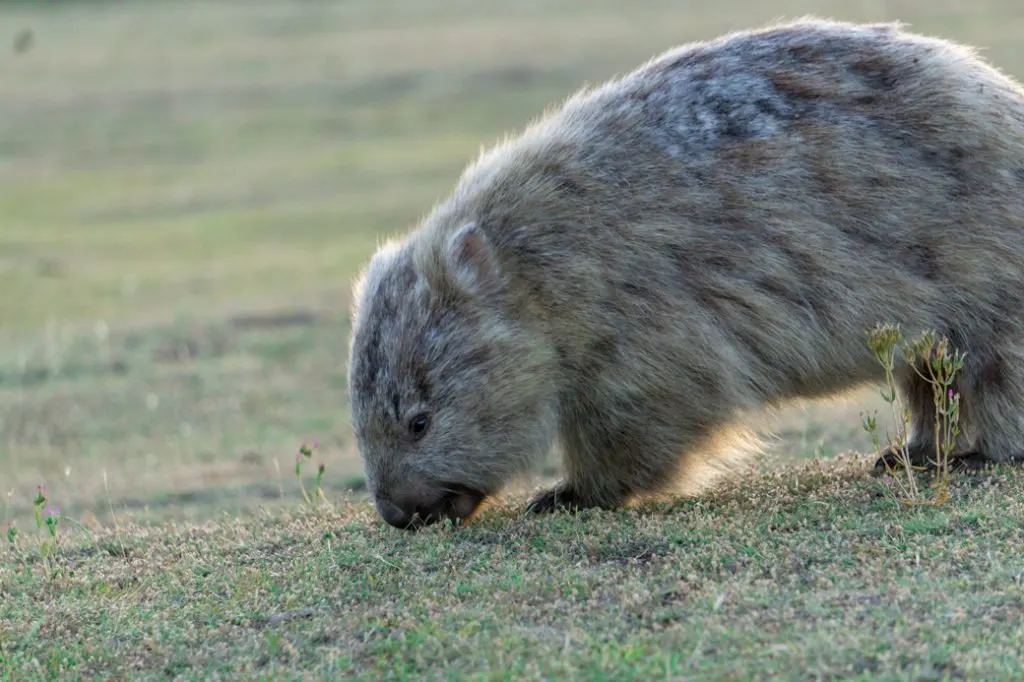
Before I went to Australia, I’d heard of wombats, but I wasn’t sure exactly what they looked like. It turns out they aren’t bats at all, but kind of a huge Australian gopher. They live underground in burrows but come out at night to munch on grasses.
I was surprised at how big wombats are – about 70cm/28″ in length. Fun fact: they have square poops.
Best places to see wombats in Tasmania: Maria Island, Cradle Mountain National Park
Possums

Tasmania has two main types of possums: the larger cat-sized brushtail possum and the smaller ringtail possum. (There are also tiny pygmy possums but they are hard to spot in the wild.)
Possums are marsupials that live in trees and are only active at night. Brushtails or brushies, are the most common and live pretty much everywhere from suburban Hobart to deep in the mountains.
Ringtailed possums are less common, a little bit smaller and have a white tipped tail that they keep curled up.
Possums are actually nuisance animals and will steal your food or garbage if you leave it out. We had a curious possum chew the lids of our water bottles one night on the Overland Track. When we camped at Wineglass Bay, a possum tried to carry our neighbour’s backpack away.
Best places to see possums in Tasmania: Overland Track in Cradle Mountain National Park, any neighbourhood at night
Echidnas

The spiky little echnida is Australia’s version of a hedgehog or porcupine… with a little bit of anteater thrown in. Echidnas have a long snout, perfect for sucking up ants and other bugs.
The Tasmanian version of the echidna has fur in between its spines to keep it warm. Fun fact: echidnas are marsupial mammals that lay eggs.
Best places to see echidnas in Tasmania: Cradle Mountain National Park, any hiking trail
Platypus
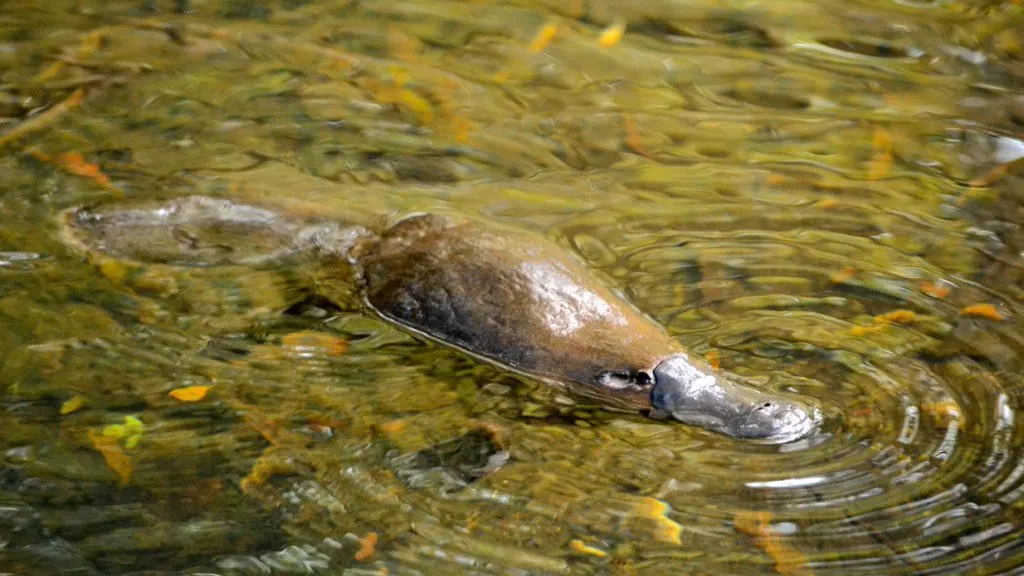
The platypus is a pretty unique creature. It has a duck-like bill, webbed feet, lives in the water and lays eggs, but its not a bird. Its a marsupial mammal!
Like many North Americans, I assumed platypuses would be beaver sized, but they’re actually really small, only about 45cm (18″) long.
Since they spend most of their time underwater or in their burrows, they can be hard to see. The best time to spot them is at dawn and dusk – look for the tell-tale bubbles on the surface as they swim, then watch for them to come up for air.
Best places to see platypus in Tasmania: Deloraine, Burnie
Little Penguins
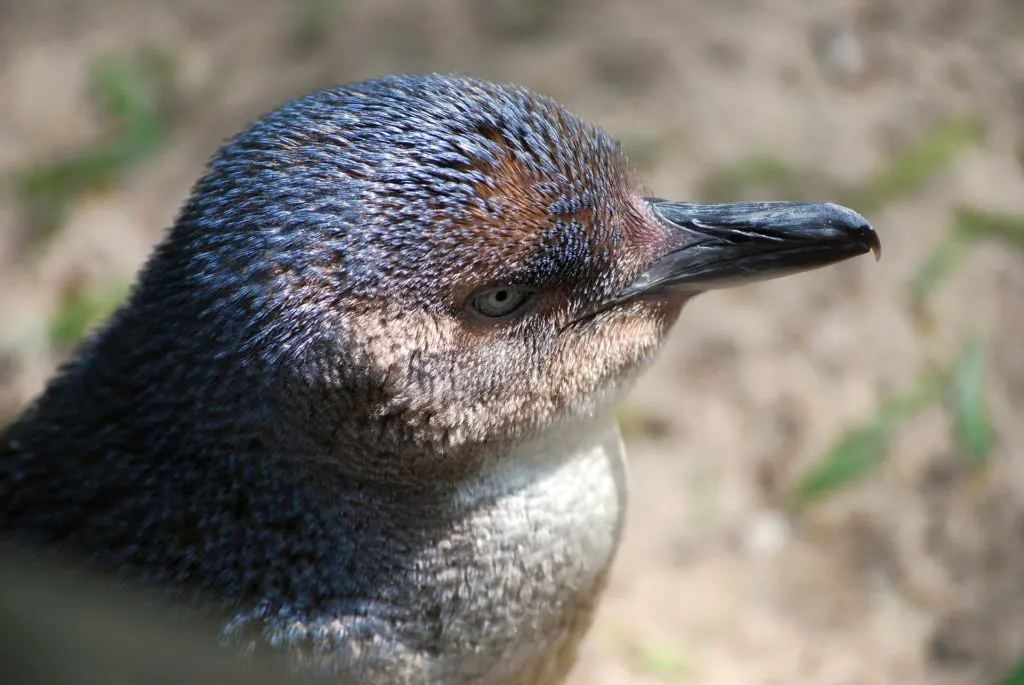
Did you know you can see penguins in Tasmania? I had no idea before I went…. and then I was super excited since they are my favourite animal.
Also known as fairy penguins, little penguins are the world’s smallest penguin species at less than 30cm (12″) tall. Thousands of penguins nest in rookeries around Tasmania in the summer. The parents leave their chicks in burrows during they day then head out to sea to fish. At dusk they return home to feed their chicks, so that’s the best time of day to see them.
Penguins are very sensitive, so use only a red flashlight (torch) for penguin viewing and leave your dog at home.
Best places to see penguins in Tasmania: Lillico Beach, Burnie, Bruny Island
Birds
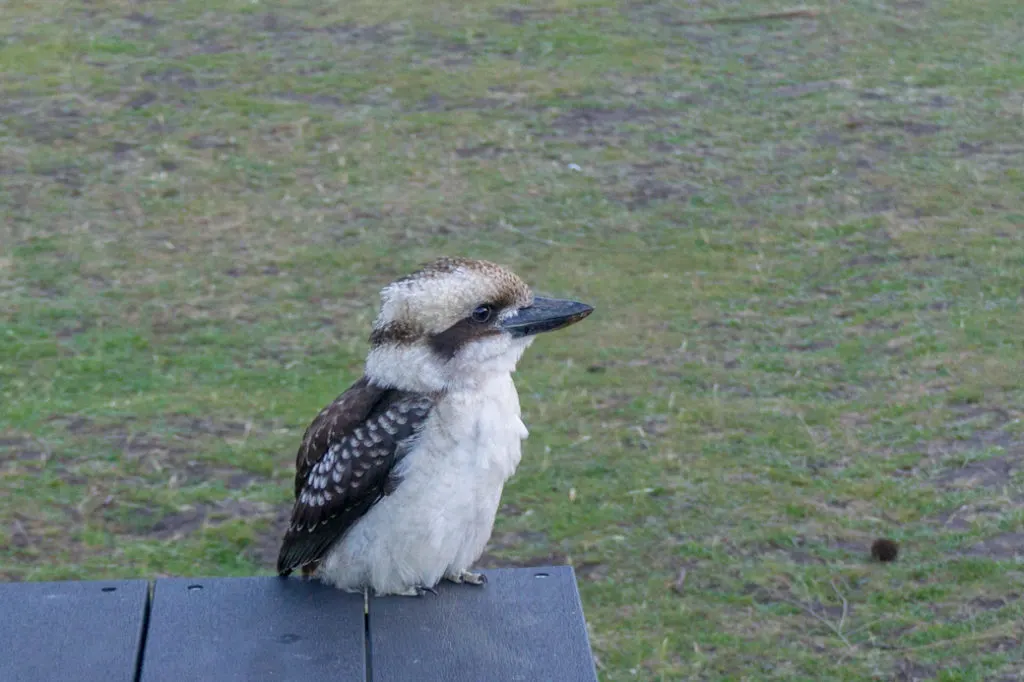
Tasmania is home to a LOT of bird species including migratory birds, sea birds, parrots and flightless birds. Some like the flightless Tasmanian Native Hen, are native only to Tasmania.
I’m not much of a birder, but I’m working on it. And I’m really bad at bird identification, so I won’t list them them here. But if you’re a bird nerd, definitely go look up the Kookaburra, Wedge-tailed Eagle, Yellow-tailed Black Cockatoo and the rare Forty-spotted Pardalote.
Best places to see birds in Tasmania: Sea cliffs, forests, national parks… depends on the type of bird.
Seals
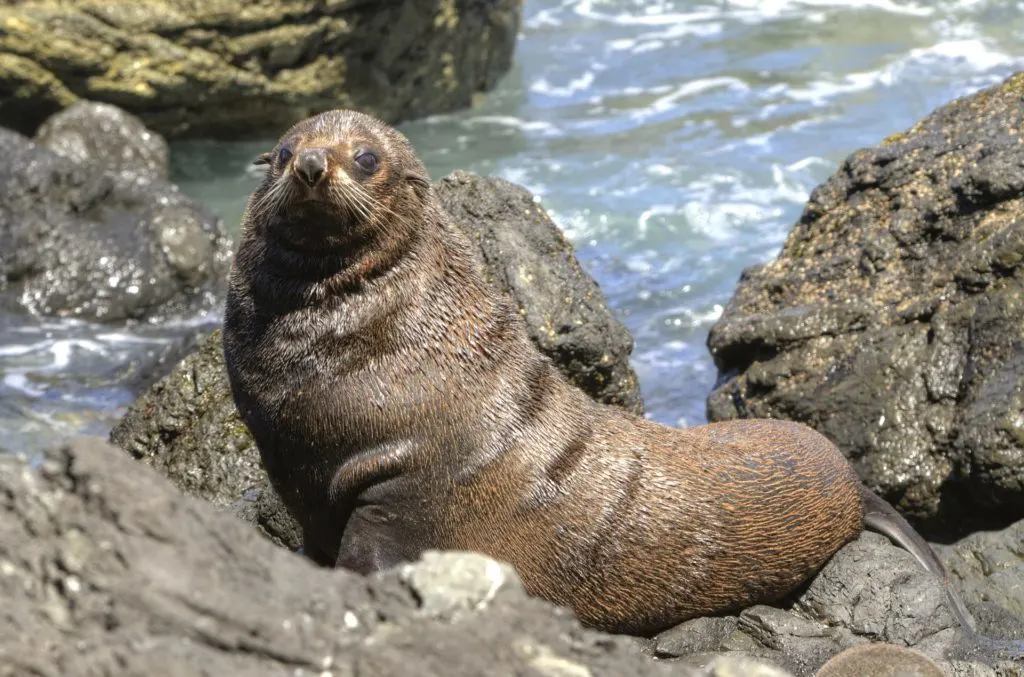
There are several seal colonies on isolated rocks off the coast of Tasmania. There are two main types of seals: Australia fur seals and long-nosed fur seals. These big seals are closely related to sea lions and can “walk” on their back flippers to get around on land.
Since the seals live off-shore, the only way to see them is on a kayak or boat tour.
Best places to see seals in Tasmania: Tasman Peninsula, Freycinet Peninsula, Bruny Island
Dolphins and Whales
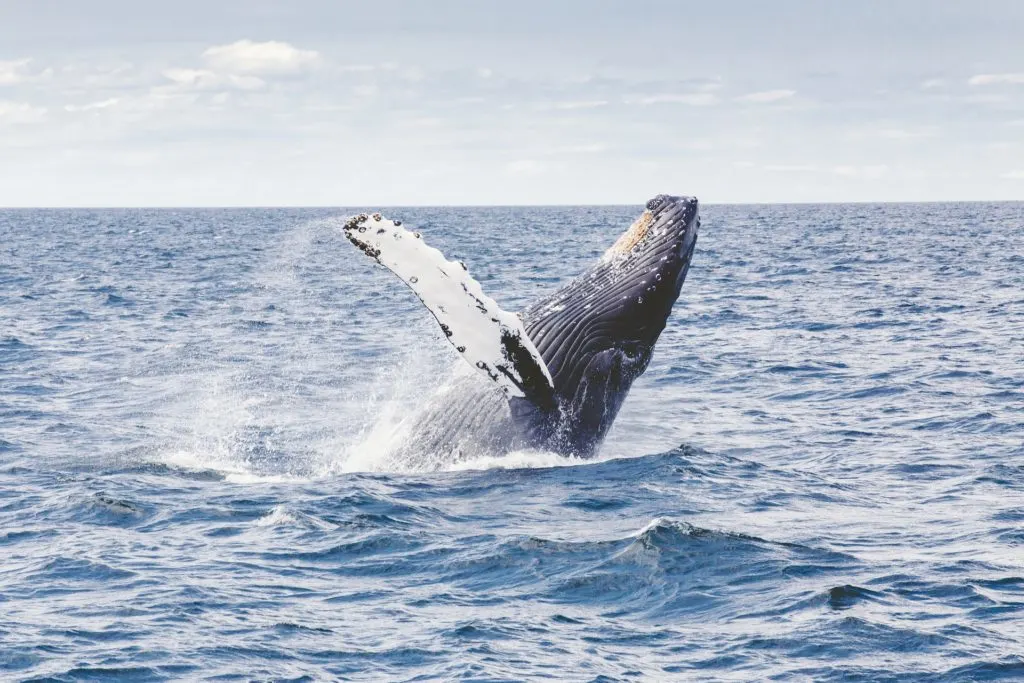
The east coast of Tasmania is along the migration route of Humpback whales and Southern Right whales, and they come in close enough that you can see them from land sometimes.
Unfortunately, I wasn’t in Tasmania during the migration season which occurs from May to July, and September to November for humpbacks, and from June to October for Southern Right whales. Common and Bottle-nosed dolphins are a frequent sight on the south east coast.
Best places to see dolphins and whales in Tasmania: Tasman Peninsula, Freycinet Peninsula, Bruny Island.
Snakes
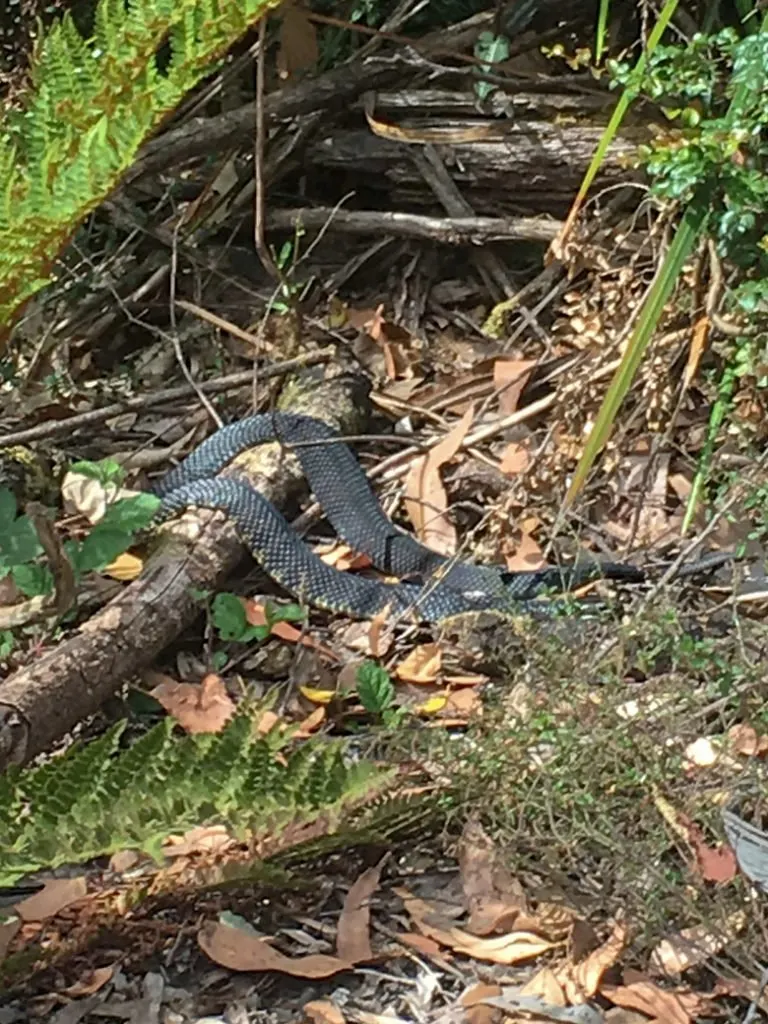
There are only three types of snakes in Tasmania, and they are all poisonous. Thankfully none of them are aggressive and usually slither off quickly when they sense people approaching. It has been over 70 years since the last fatal snake bite in Tasmania and most people who are bitten are trying to either catch or kill snakes. If you leave them alone, they’ll leave you alone.
The three types of snake are the copperhead, tiger snake and white-lipped snake. They live pretty much everywhere in Tasmania so watch out for them on hiking trails throughout the state, especially on sunny days.
Best places to see snakes in Tasmania: Narawantapu National Park, Cradle Mountain National Park, Lake St. Clair National Park
Skinks
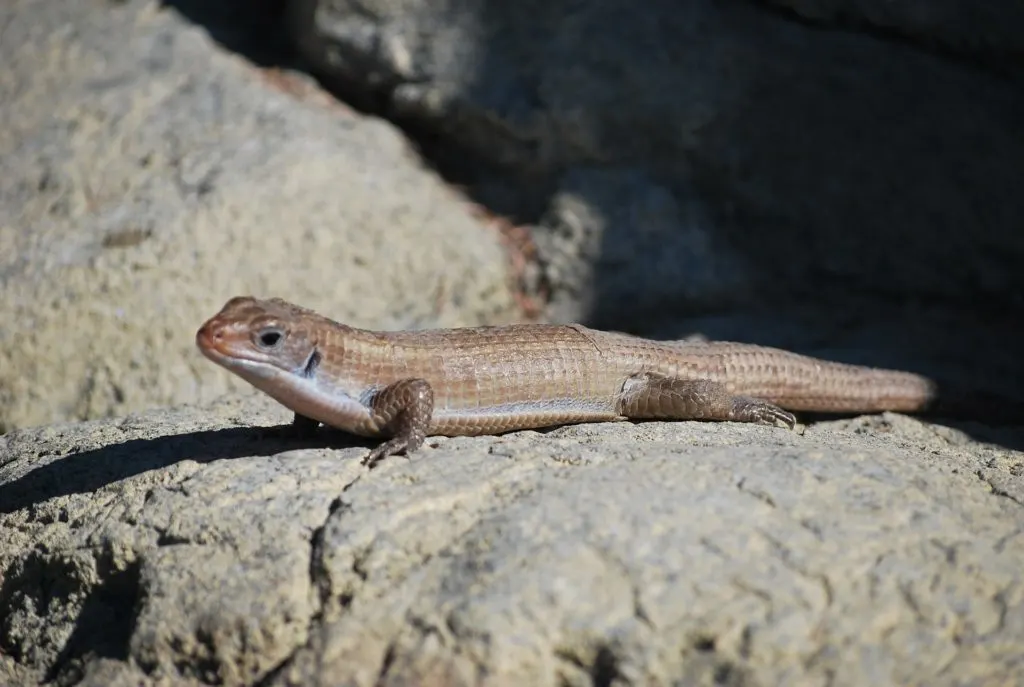
Skins are the most common lizards in Tasmania. They are usually quite small at about 10cm (4″) long with metallic skin. They eat bugs, so they are actually great to have around. You can see them everywhere in Tasmania, including in people’s front gardens. We had resident skinks on the patio at our house-sit.
Best places to see skinks in Tasmania: watch out for them sunning themselves on hiking trails on sunny days, especially on the boardwalks
Best Places to See Wildlife in Tasmania
You can spot common wildlife like skinks, birds and wallabies pretty much everywhere in Tasmania. But to see other wildlife, you’ll have to seek them out. Here are my picks for the 10 best places to see wildlife in Tasmania.
1. Tarkine Region and the West Coast

The remote West Coast and Tarkine Region in Tasmania’s North West is home to the world’s second largest temperate rainforest. It’s a wild area that is largely uninhabited and supports lots of wildlife. Since it is so remote, it supports one of the remaining wild populations of Tasmanian devils.
I took a road trip through the Tarkine and stopped for lots of hikes. One night at dusk in our campground in Arthur River we were lucky enough to see a Tasmanian Devil from about 100m away! It was the best wildlife sighting of our whole trip since it was so unexpected.
Animals You Can See in the Tarkine and the West Coast: Tasmanian Devils, birds, wallabies, pademelons
READ NEXT: The Ultimate Guide to the Tarkine Drive in Tasmania, Australia
2. Burnie
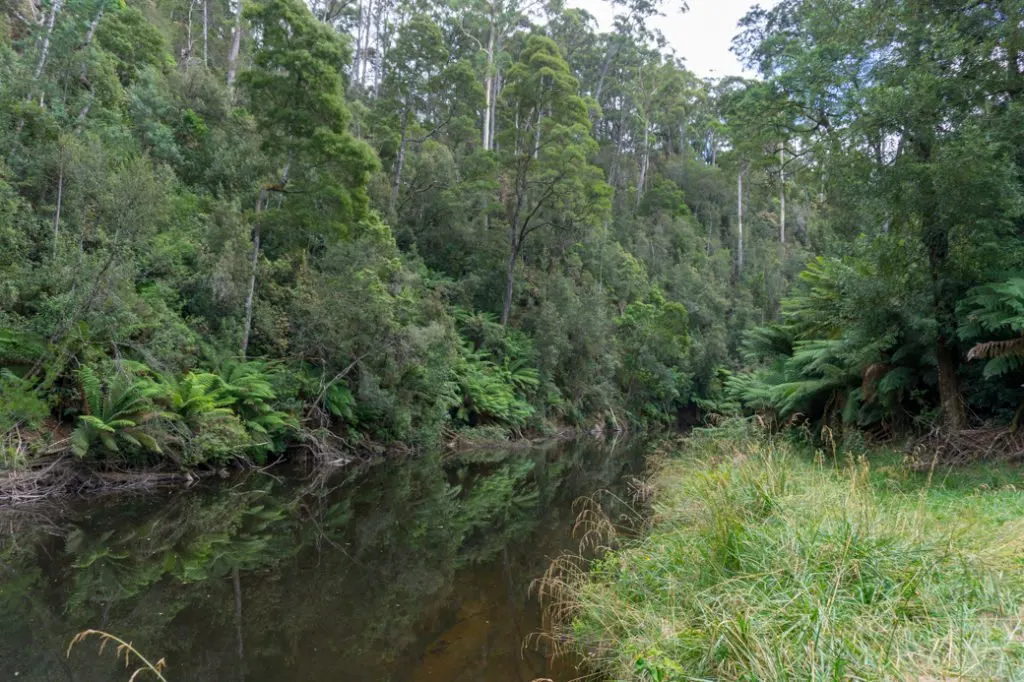
The North West coast town of Burnie is known as an industrial centre, but its actually still a good place to spot wildlife. You can watch penguins come ashore each night from October to March at the Penguin Observation Centre near the CBD. Volunteer guides are on hand to answer questions.
Head to Fern Glade Reserve just outside of Burnie for a great chance of spotting a platypus. There’s a short walking track along the river lined with fun interpretive signs to help you learn about platypuses.
Animals You Can See in Burnie: Little penguins, platypuses
3. Lillico Beach
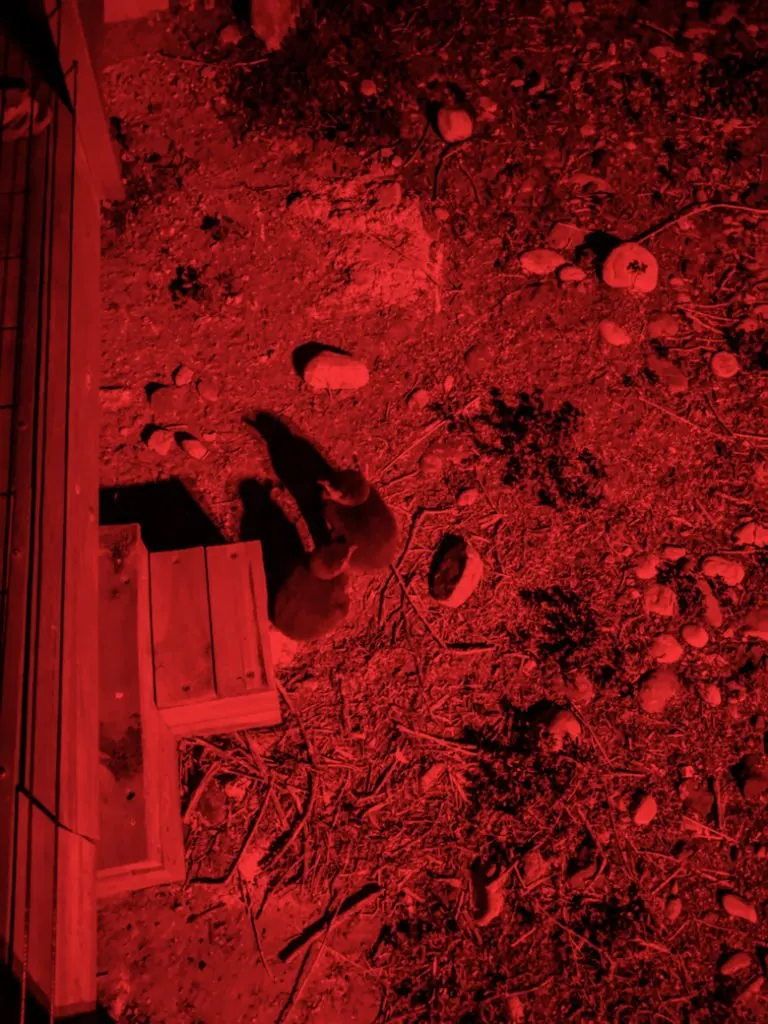
Lillico Beach Conservation Area is located just 5 minutes from Devonport. There’s a large viewing platform equipped with special red lights that let you see little penguins without scaring them with bright lights.
Some of the penguin burrows are right next to the platform so you can get really close views of the chicks as their parents feed them dinner. Volunteer guides have additional red lights to help you see and can answer questions. You can generally find penguins here between September and April.
This penguin viewing area was just a few minutes drive from where we were house-sitting and I loved it so much we went about once a week!
Animals You Can See at Lillico Beach: Little penguins
4. Narawntapu National Park
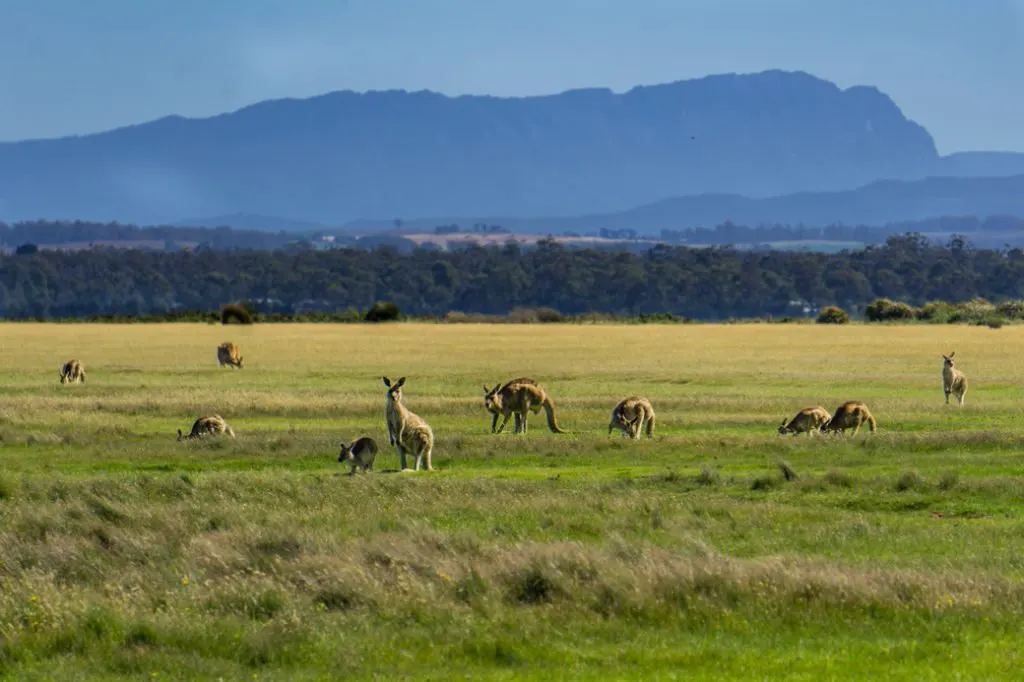
This under-the-radar national park is located along the coast in between Devonport and Launceston. It’s been called the Serengeti of Tasmania, and I think it lives up to its reputation.
The open grassy areas near the visitor centre are great for spotting kangaroos. The campground has resident wallabies and Tasmanian Native Hens. If you hike the trails you’ll spot pademelons hiding in the bushes or snakes sunning themselves.
There’s also an elevated boardwalk that heads out to a bird hide on the lagoon where you can spy on ducks, black swans and other water birds.
Lastly, Narawntapu is reportedly still home to a small population of endangered Tasmanian devils.
Animals You Can See at Narawntapu National Park: Kangaroos, wallabies, pademelons, snakes, birds, Tasmanian devils
5. Cradle Mountain-Lake St. Clair National Park
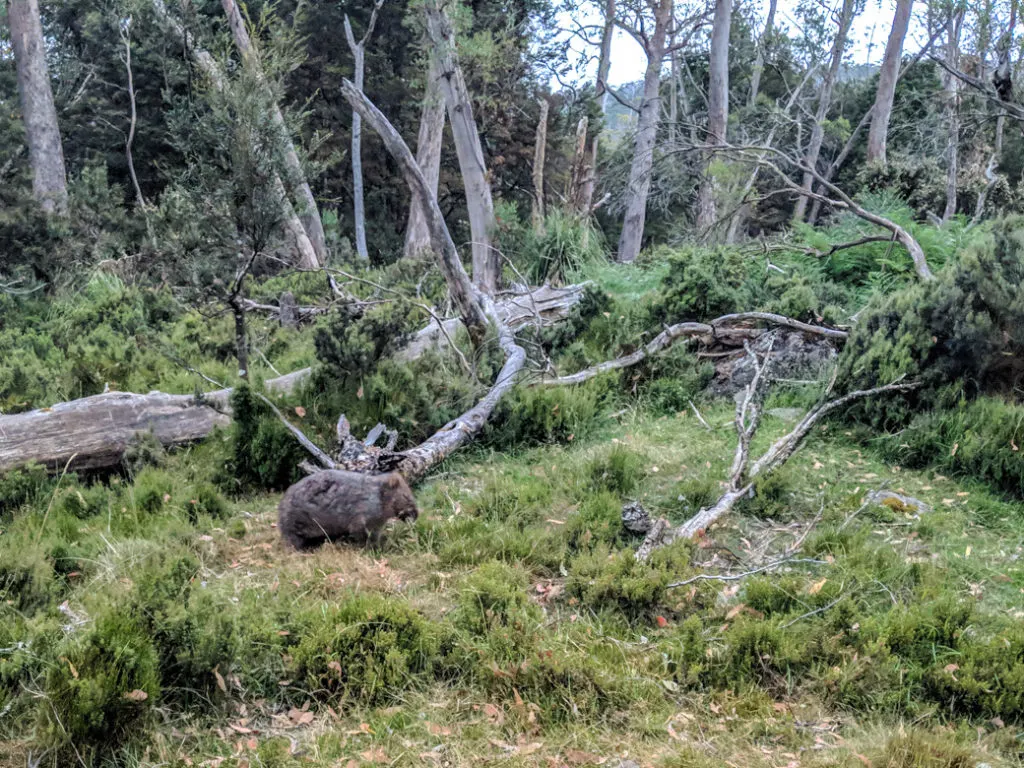
Set in the mountainous highland plateau of Tasmania, Cradle Mountain-Lake St. Clair National Park should be on every wildlife tourist’s bucket list. There are tons of opportunities to see wildlife.
The Ronny Creek area near the entrance to Cradle Mountain park has a huge wombat and wallaby population. You’ll also spot lots of birds and maybe even an echidna along the hiking trails.
If you opt to stay overnight in one of the lodges at Cradle Mountain, be sure to take a nighttime wildlife tour. Since most of the animals are nocturnal and hard to find, going with a guide is a great way to see more animals.
At Lake St. Clair, snakes are very common on sunny days and you’re bound to spot birds, wallabies and pademelons on the trails near the visitor centre. If you hike the short distance down to Platypus Bay at dawn or dusk, you might be rewarded with an elusive platypus sighting.
If you take on the challenge of walking the 65km Overland Track deep in the heart of the parks, you’ll have tons of opportunities to spot wildlife. Many of the campgrounds have resident wallabies, pademelons, wombats and possums.
The walking track has many boardwalks, which are a favourite spot for skinks. We saw literally dozens of skinks each day. If you keep an eye out you might spot snakes or echidnas beside the trail too.
Animals You Can See at Cradle Mountain-Lake St. Clair National Park: Wombats, wallabies, pademelons, possums, snakes, echidnas, skinks, birds
READ NEXT: Hiking the Overland Track in Tasmania
6. Deloraine
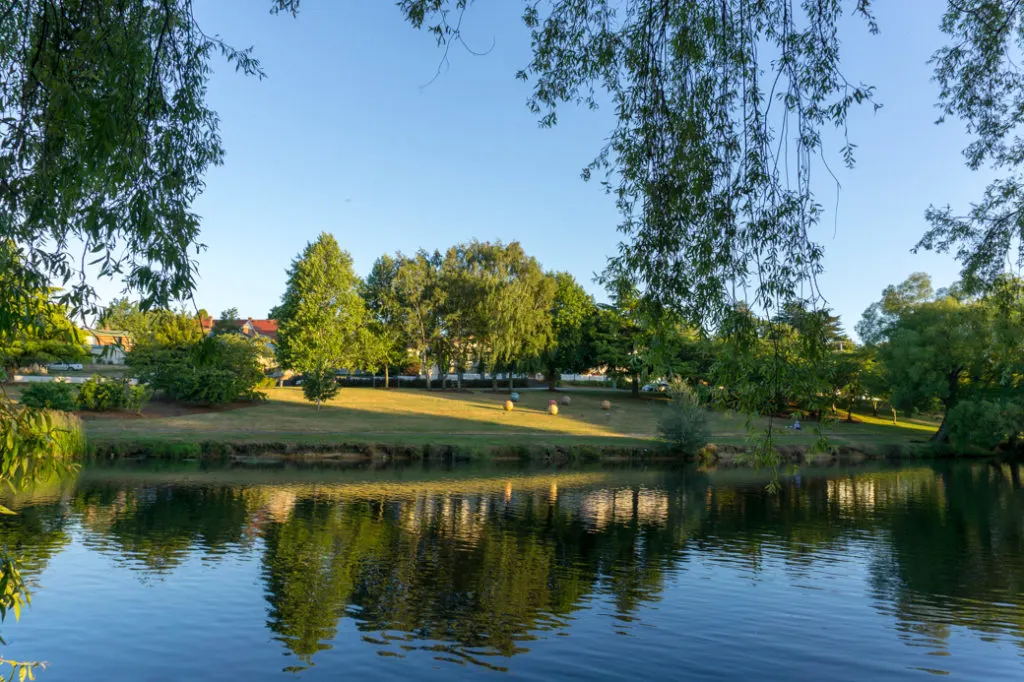
Platypus are notoriously hard to spot. I finally saw my first platypus in the wild in Deloraine!
Mark, the owner of The Empire Hotel in the northern town of Deloraine, runs free platypus tours most nights in the summer. His walking tour explains facts about the platypus, then takes you along the river to his favourite platypus spotting areas.
Animals You Can See in Deloraine: Platypuses
READ NEXT: 40+ Things to do in Devonport and Tasmania’s North West
7. Maria Island National Park
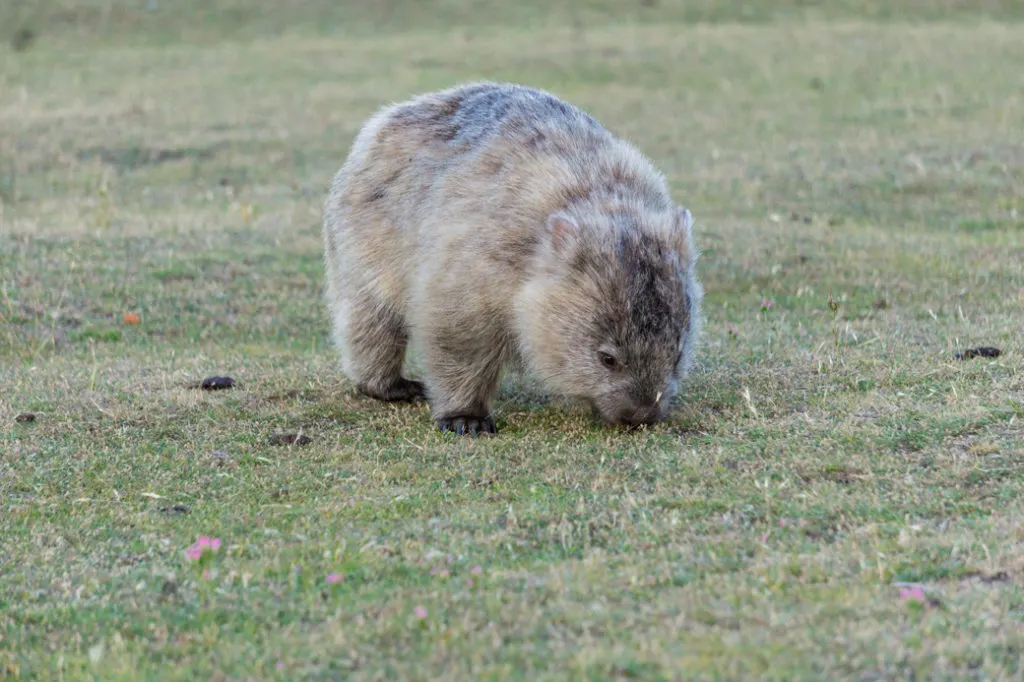
In my opinion, Maria Island is by far the best place to see wildlife in Tasmania. But there’s a catch… you have to stay overnight. Since the whole island is a National Park, that means camping or staying in rustic accommodation in the old prison. But it’s definitely worth it.
On the ferry ride over, keep your eyes peeled for dolphins and whales. During the day watch for lots of birds including huge Cape Barren geese.
But once the sun starts to go down, all the mammals come out. The large open field by the campground gets covered in wombats, wallabies and pademelons. The occasional kangaroo hops through, or you can walk out towards the airstrip where they hang out. Possums dart through the trees.
And if you listen, you might hear the horrible growling and screaming of the Tasmanian Devil. Since the island is isolated, Maria Island is one of the key places for the reintroduction of captive bred Tasmanian devils.
Reportedly the devils sometimes wander through the campground after dark, especially if someone is barbecuing meat. Unfortunately I heard them but didn’t see them.
Animals You Can See on Maria Island: Wombats, Tasmanian devils, kangaroos, wallabies, pademelons, possums, birds, Cape Barren geese, dolphins, whales
READ NEXT: How to Visit Maria Island, Tasmania
8. Freycinet National Park
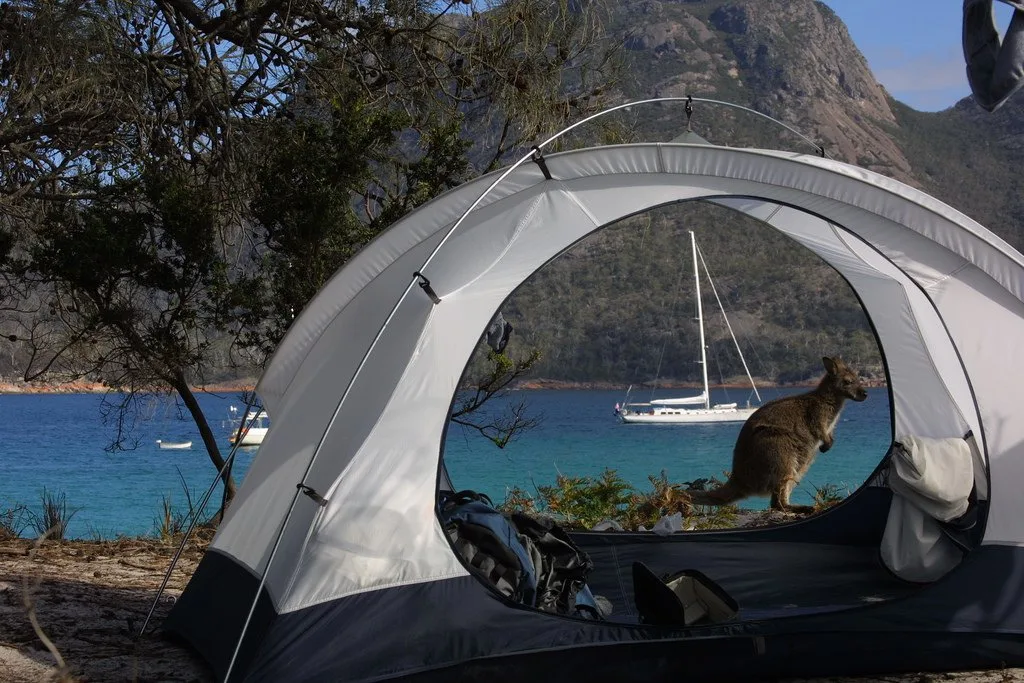
Freycinet National Park is famous for gorgeous Wineglass Bay. But the trails through the park and the waters surrounding the peninsula are a great place to spot wildlife.
The campsites are known for their friendly wallabies, pademelons, possums. You can also spot wallabies, pademelons, echidnas, snakes and many species of birds along the park trails. Look for dolphins, seals and migrating humpback and southern right whales off shore.
Animals You Can See on the Freycinet Peninsula: wallabies, pademelons, possums, whales, snakes, birds
9. Tasman peninsula

The Tasman Peninsula is almost completely cut-off from the mainland by the narrow Eaglehawk Neck. That means that there is lots of diverse wildlife on the peninsula.
Watch for echidnas and pademelons on the hiking trails. In the remote Fortescue Campground watch for wallabies hopping through or possums and bandicoots prowling after dark. There is a small surviving population of Tasmanian Devils on the peninsula but sightings are rare.
The towering cliffs of the peninsula are best seen from the water. We loved taking a boat tour on our trip. The tours visit seal colonies and can also track down migrating whales and dolphins.
Animals You Can See on the Tasman Peninsula: Echidnas, pademelons, wallabies, possums, bandicoots, Tasmania devils, seals, dolphins, whales and sea birds.
READ NEXT: 20+ Things to Do on the Tasman Peninsula Near Port Arthur
10. Bruny Island
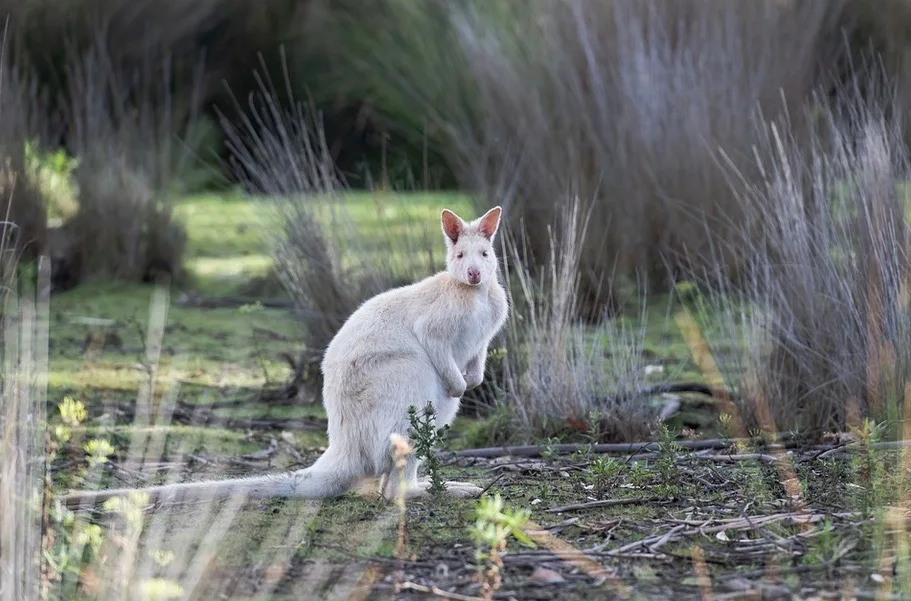
Bruny Island south of Hobart is a paradise for foodies. But it also has lots of wilderness areas that are great for spotting animals like. It’s a great place to echidnas and little penguins.
But the real reason I visited was to see the population of rare white wallabies. The albino wallabies have few predators on the island, which is what has allowed them to survive. We saw lots of regular wallabies, but sadly, none of the famous white ones.
Eco-friendly boat tours are a great way to see marine life like seals, whales and sea birds.
Animals You Can See on Bruny Island: Echidnas, seals, little penguins, whales, white wallabies
READ NEXT: The Best Things to Do on Bruny Island, Tasmania
So there are my recommendations for the best places to see wildlife in Tasmania. The little penguins and wombats were definitely my favourite, and I still can’t believe I saw a Tasmanian devil in the wild! So lucky!
If you go to Tasmania, definitely make sure you make seeing animals a priority and of course keep ethical animal encounters top of mind. Which Tasmanian animal are you most excited to see? Tell me in the comments.
MORE TASMANIA POSTS:
- The Ultimate Guide to the Tarkine Drive in Tasmania, Australia
- 40+ Things to do in Devonport and Tasmania’s North West
- The Ultimate Guide to the Overland Track in Tasmania
- How to spend the weekend in Hobart, Tasmania: 2-day Itinerary
- 22 Things to Do on the Tasman Peninsula Near Port Arthur
- The Ultimate Guide to Visiting Maria Island, Tasmania
- The Best Things to Do on Bruny Island, Tasmania
- The Best Things to do in Strahan and Tasmania’s West Coast
- The Best (and Worst) Backpacking Meals Reviewed - December 16, 2025
- My Favourite Hiking Gear of 2025 - December 9, 2025
- Best Insulated Skirts For Hiking and Snowshoeing in 2026 - December 5, 2025

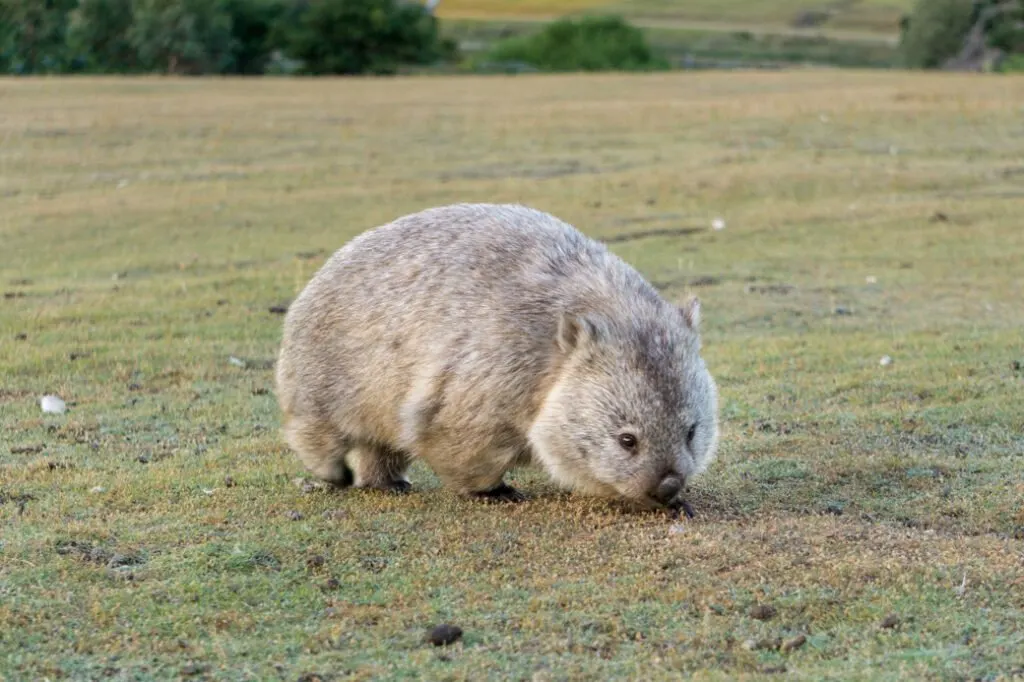

Yuka
Friday 11th of March 2022
This article is exactly what I am looking for! Which month do you recommend to go Tasmania just to spot wildlife? I am planing to go there in the early April. It is becoming cool and I am worried about weather, especially rain... Is it still good season to visit?
Taryn Eyton
Saturday 12th of March 2022
You're right that weather in April can be a bit colder and wetter than summer, making it a bit more challenging to see wildlife. But it's possible to see wildlife year round, especially at places like Cradle Mountain, Maria Island, and Narawantapu. Have a great trip.
Linda Gerbec
Thursday 23rd of December 2021
What a great article. I had no idea you could see so many interesting species in Tasmania. It is definitely being added to my itinerary.
Mike Honeycutt
Friday 11th of December 2020
Love this content Taryn, very well-written! Traveling is the best possible option to achieve peace of mind that many people hunger for. If you are a person who loves animals, you should take on a travel trip to see them. If you are still deciding on what place to visit for your next adventure, you should consider wildlife destinations.
Tom
Thursday 26th of March 2020
Hi Taryn, to be honest, i am not very active on social media. To be be more precise: i am not active there at all...and with +40 of age already too old :) When i am done with editing, i could forward a vimeo or flickr link to your administrator email, if you are interested (but image quality is not the best, as you could imagine with a 40€ camera - but still possible to ID the creatures in most cases...). Best greetings! Tom
Tom
Wednesday 25th of March 2020
Hey Taryn! I just wanted to say "thank you!" for this wonderful Tassie Wildlife guide! All required infos in one place! It was so helpul for planning my trip! I could spot so many creatures, all i "wanted" to see plus so many more unexpected surprises...just mindblowing (the white wallabies are still around on Bruny :)). I could literally write a book about what i have seen...+10k pictures + videos (incl. night vision camera trap, which turned out to be the fun ) will take several months of editing....puhhhh :). And your guide was a key-contributor to this. So again: Thank you!
Taryn Eyton
Wednesday 25th of March 2020
Oh that's so cool Tom! Would love to see some of your photos, especially the night vision ones. Will you be sharing them online somewhere?